Lifestyle
Discover Tanning Lotions for Radiant, Lasting Glow
Discover the best tanning lotions for a radiant glow that lasts, and unlock the secrets to achieving your perfect sun-kissed complexion!
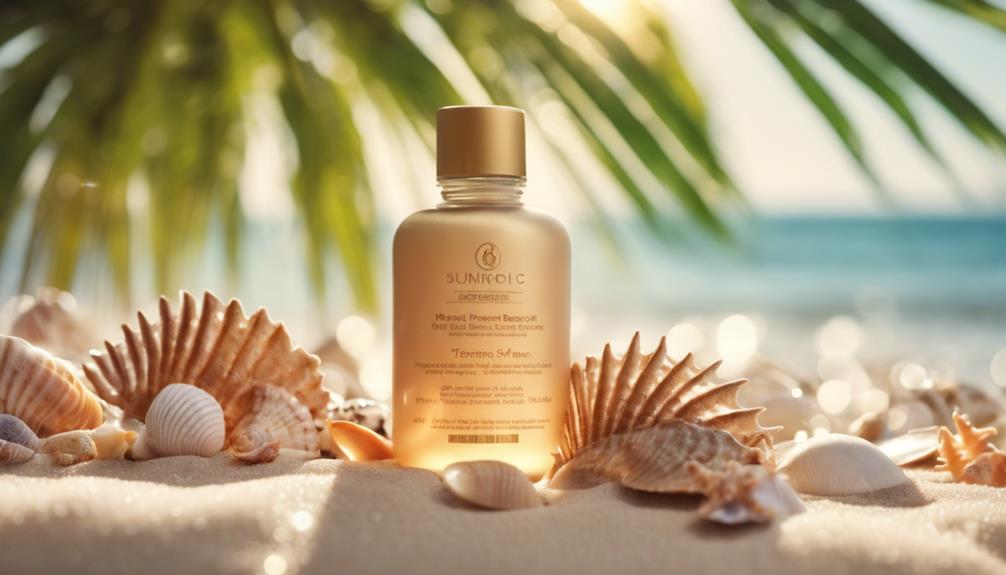
To discover tanning lotions for a radiant, lasting glow, start by evaluating your skin type. If you have sensitive skin, choose oil-free, hypoallergenic products. For dry skin, opt for rich moisturizers that boost hydration. Look for ingredients like tanning accelerators, shea butter, and antioxidants, which enhance your tan and protect your skin. Applying lotion evenly is essential, so don't forget gloves or wash your hands after. Always pair your tanning lotion with sunscreen for safety. With the right products and techniques, you can achieve a beautifully bronzed look that lasts. There's much more to uncover about maintaining that glow!
Key Takeaways
- Choose tanning lotions tailored to your skin type for optimal hydration and color development.
- Look for key ingredients like tanning accelerators, moisturizers, and antioxidants for enhanced results.
- Opt for products that provide skin hydration to prevent peeling and maintain a smooth tan.
- Apply lotion evenly and allow absorption before sun exposure for best results.
Key Considerations for Tanning Lotions
When choosing tanning lotions, it's crucial to take into account your skin type and hydration needs to achieve the best results.
If you have sensitive skin, opt for oil-free, hypoallergenic formulas to minimize irritation. For oily skin, lightweight, quick-absorbing lotions work best, while dry skin requires richer moisturizers to enhance hydration.
Look for lotions containing tanning accelerators to boost melanin production, guaranteeing a faster tan. Additionally, consider products with tattoo fade protectors if you have body art, as they help maintain ink vibrancy.
Always purchase from reputable sellers to confirm authenticity and quality. Don't forget to check for personal scent preferences and potential allergens to guarantee a pleasant tanning experience.
Benefits of Skin Hydration
Hydrated skin not only enhances the tanning process but also helps maintain an even and long-lasting glow. When your skin's moisture levels are ideal, it absorbs tanning products more effectively, leading to richer color development.
Proper hydration reduces the risk of peeling, ensuring your tan remains smooth and streak-free. Additionally, well-moisturized skin feels softer and looks healthier, making your overall appearance more radiant.
Don't forget that drinking plenty of water complements topical hydration, boosting your skin's elasticity and energy. By prioritizing skin hydration, you set the foundation for a beautiful tan that lasts longer and looks more vibrant.
Essential Ingredients to Look For
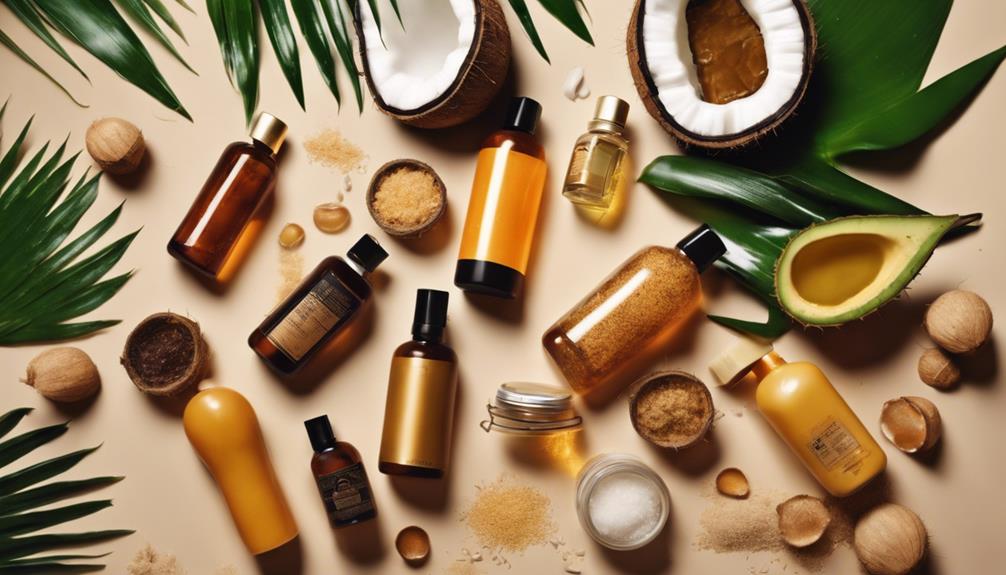
Look for key ingredients like tanning accelerators, moisturizers, and antioxidants to maximize the effectiveness of your tanning lotion. These components not only enhance your tan but also keep your skin healthy and hydrated.
Here are some must-have ingredients:
- Tanning Accelerators: Look for tyrosine or similar compounds that boost melanin production for faster tanning.
- Moisturizers: Ingredients like shea butter, coconut oil, and hyaluronic acid keep your skin soft and prevent peeling.
Choosing Lotions by Skin Type
Selecting the right tanning lotion is crucial, as it should align with your specific skin type to achieve the best results and maintain skin health.
If you have sensitive skin, opt for oil-free, hypoallergenic formulas to avoid irritation.
For oily skin, choose lightweight, quick-absorbing lotions that won't clog pores.
If your skin's on the drier side, go for rich, moisturizing products packed with ingredients like shea butter or coconut oil to keep your skin hydrated.
Combination skin may require different products for various areas.
If you're acne-prone, look for lotions containing tea tree oil or salicylic acid to minimize breakouts.
Tailoring your choice guarantees a radiant, long-lasting tan while prioritizing your skin's needs.
Effective Application Techniques
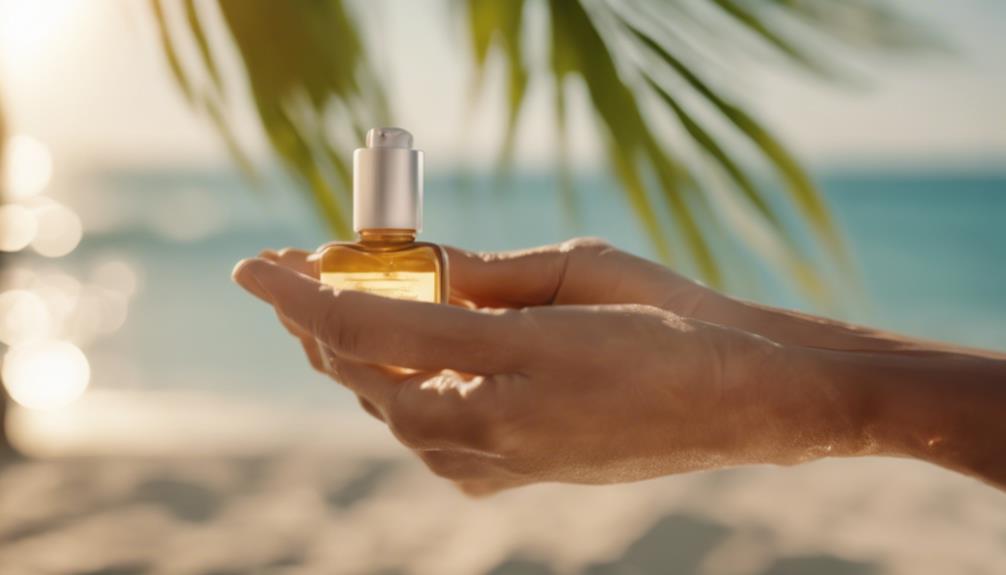
Achieving a flawless tan hinges on mastering effective application techniques that guarantee even coverage and ideal results. Start by applying the lotion liberally to avoid streaks or missed spots.
Remember these key tips:
- Use gloves or wash your hands immediately after application to prevent discoloration.
- Allow the lotion to absorb completely before sun exposure or using a tanning bed.
Safety Measures and Precautions
Prioritizing safety is crucial when using tanning lotions to protect your skin from potential harm and guarantee ideal results.
Always apply sunscreen alongside your tanning lotion, as it provides essential UV protection. Monitor your skin for any unusual reactions during and after tanning sessions; if you notice irritation or discomfort, consult a dermatologist for personalized advice.
Avoid excessive sun exposure and tanning bed use to prevent skin damage. Additionally, make sure you purchase products from reputable sellers to avoid counterfeit products that may not be safe.
Always follow the manufacturer's instructions for application and consider patch testing new products to rule out any adverse reactions.
User Experiences and Ratings

Many users rave about their experiences with tanning lotions, highlighting fast results and enjoyable scents that enhance the overall process.
You'll find that individual feedback often emphasizes a few key aspects:
- Speed of Results: Many users appreciate how quickly they achieve a bronzed look.
- Pleasant Scents: A lot of lotions feature delightful fragrances that make the application enjoyable.
However, some products may feel a bit pricey for the quantity, yet their effectiveness often justifies the cost.
Recommended Tanning Products
With so many positive user experiences highlighting speed and scent, it's time to explore some top recommended tanning products that can help you achieve that radiant glow.
Australian Gold Rapid Tanning Intensifier Lotion is a favorite for its quick results and nourishing ingredients like Tea Tree Oil.
If you're after something deeper, try b.tan I Want The Darkest Tan Possible UV Tanning Lotion, packed with x4000 tanning intensifiers.
For tattoo protection, consider Ed Hardy Coconut Kisses Golden Tanning Lotion, which hydrates while safeguarding your ink.
JWOWW Fit Life Dynamic Dark Intensifier offers a pleasant aroma and superb moisture.
Finally, HEMPZ Hydromax Maximizer combines natural hemp seed oil with dark tan enhancers for an unbeatable glow.
Choose the one that fits your skin type for the best results!
Frequently Asked Questions
How Long Does a Typical Tanning Lotion Last After Application?
A typical tanning lotion lasts about 4 to 8 hours after application, depending on your skin type and activity level. To maximize results, reapply as needed, especially after swimming or sweating.
Can Tanning Lotions Be Used Indoors and Outdoors?
Yes, you can use tanning lotions both indoors and outdoors. Just guarantee you choose the right product for your environment, and always apply sunscreen when outdoors to protect your skin from UV damage.
Are There Tanning Lotions Suitable for All Skin Tones?
Yes, there are tanning lotions designed for all skin tones. Look for products with broad-spectrum ingredients that enhance melanin production and provide hydration, ensuring everyone can achieve a beautiful, natural-looking tan regardless of their skin type.
What Should I Do if I Experience a Rash After Using a Lotion?
If a rash appears after using a lotion, don't ignore it. Rinse the area gently, stop using the product, and consult a dermatologist. Your skin's telling you something important—it's better to listen early.
How Often Should I Reapply Tanning Lotion During Sun Exposure?
You should reapply tanning lotion every two hours during sun exposure, or more frequently if you're swimming or sweating. This guarantees even coverage and helps maintain your tan while protecting your skin from UV damage.
Conclusion
Just like a gardener nurtures their plants to bloom, you too can cultivate that radiant, lasting glow with the right tanning lotion.
By tending to your skin's unique needs, choosing nourishing ingredients, and applying with care, you'll watch your tan flourish.
Remember to protect your body art and prioritize hydration, allowing your skin to shine like a well-tended flower in the sun.
So go ahead, embrace the journey to your perfect sun-kissed allure!
Lifestyle
Unlock Your Best Tan With Smart Sessions
Incorporate tailored tanning sessions to enhance your glow and discover secrets for maintaining a radiant tan that lasts!

You can access your best tan by tailoring your sessions to your skin type. Start with short sessions and gradually increase their length, keeping in mind that fair skin needs fewer visits than darker tones. Preparing your skin is essential: exfoliate 24 hours prior and hydrate well. After tanning, moisturize immediately to keep your glow vibrant. Aim for regular sessions, but know when to ease back to maintain your color effectively. By understanding your skin and following these steps, you'll achieve a radiant tan. There's more to explore on enhancing your tanning experience and keeping it fresh!
Key Takeaways
- Assess your skin type using the Fitzpatrick Scale to determine optimal tanning frequency for best results.
- Prepare your skin by exfoliating 24 hours prior and arriving makeup-free for even product application.
- Start with short tanning sessions to gauge your skin's response, gradually increasing duration as needed.
- Maintain hydration by drinking water and using a moisturizer before and after tanning to enhance results.
Understanding Your Skin Type
To reveal your best tan, start by identifying your skin type using the Fitzpatrick Scale, which helps you tailor your tanning strategy effectively. This scale categorizes skin into six types based on how easily it burns and tans.
If you have fair skin, you'll want to begin with brief sessions to establish a base tan, while medium skin types can handle slightly longer sessions. Olive skin types can enjoy more frequent sessions, but even darker skin must exercise caution.
Follow the recommended frequencies: fair (1-2 times a week), medium (2-3), olive (3-4), and darker (4-5). Adjust your session duration as your skin adapts to guarantee ideal results without overexposure.
Preparing for Your Session
Exfoliating your skin 24 hours before your tanning session helps eliminate dead skin cells, ensuring a smooth and even tan.
After exfoliation, it's essential to hydrate your skin adequately; dry skin doesn't tan well. Make sure to moisturize regularly leading up to your session to keep your skin in ideal condition.
When you arrive for your tanning session, come with clean, makeup-free skin. This allows for an even application of the tanning product or UV rays.
Avoid using any lotions or oils that might interfere with the tanning process. By following these simple steps, you'll set the stage for achieving that beautiful, bronzed glow you desire.
Preparing properly maximizes your results and enhances your tanning experience.
Managing Tanning Sessions
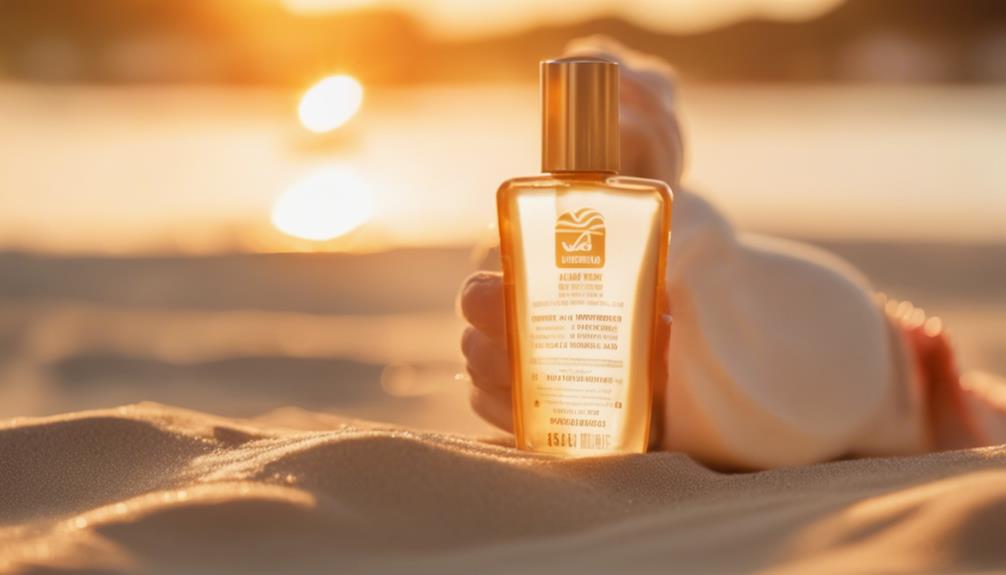
Managing your tanning sessions effectively is essential for achieving a deep and even tan while minimizing the risk of skin damage.
Start with short sessions to gauge your skin's response, gradually increasing the duration as your skin adapts. Aim for a balanced schedule—limit yourself to one session per day.
For initial color development, you might need 3-5 sessions, especially if you have lighter skin. Once you've reached your desired shade, cut back to 2 sessions weekly for maintenance.
Consider alternating tanning beds to benefit from different wavelengths, promoting an even tan and preventing overexposure in certain areas.
Always listen to your skin and adjust your routine as needed to keep it healthy and glowing.
Post-Tanning Care
Applying moisturizer immediately after tanning helps prevent peeling and keeps your skin hydrated.
To maintain that gorgeous glow, incorporate these essential post-tanning care tips into your routine:
- Use a professional tan extender to prolong your tan and enhance its vibrancy.
- Stay hydrated by drinking plenty of water; it's vital for keeping your skin looking its best.
- Avoid hot showers or baths for the first 24 hours post-tan to preserve your color.
Health and Safety Tips
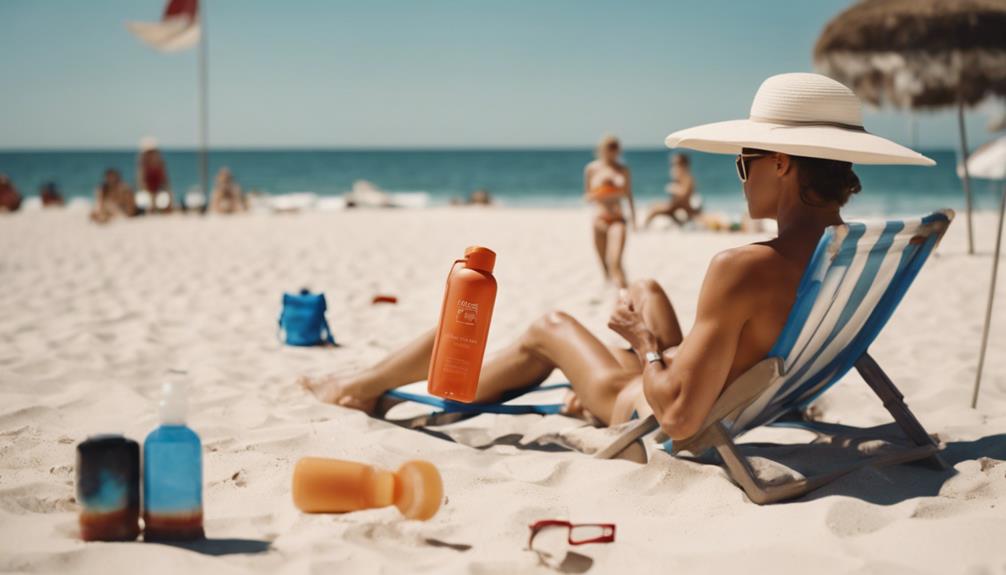
Understanding your skin's limits is essential to enjoying a safe and effective tanning experience. Always start with short tanning sessions to gauge how your skin reacts.
If you have fair skin, limit your sessions to 1-2 times a week, while darker skin types can go up to 4-5 times. Hydration is key—drink plenty of water and use a good moisturizer before and after tanning.
Rotate your position during sessions to avoid uneven tan lines. Keep an eye on your skin; if you notice any irritation or redness, give it a break.
Above all, patience is crucial; gradual exposure leads to the best results without damaging your skin. Stay informed about safety practices for a healthier tanning experience.
Frequently Asked Questions
How Can I Tell if a Tanning Bed Is Safe?
To determine if a tanning bed's safe, check for recent certifications, guarantee it's well-maintained, and confirm the bulbs are functioning properly. You should also read reviews and ask staff about their safety practices.
What Are the Signs of Overexposure to UV Rays?
Signs of overexposure to UV rays include redness, swelling, blistering, and peeling skin. You might also experience discomfort, fever, or chills. If you notice these symptoms, it's essential to minimize further sun exposure immediately.
Can I Tan if I Have a Skin Condition?
You can tan with a skin condition, but it's essential to consult your dermatologist first. They'll help you understand any risks and recommend safe tanning practices tailored to your specific needs. Stay cautious!
How Long Does a Tan Typically Last?
A tan typically lasts about 7 to 10 days, depending on your skin type and care. Moisturizing and exfoliating can help extend its life, while sun exposure can fade it more quickly.
Are There Any Foods That Enhance Tanning Results?
Eating foods rich in carotenoids, like carrots, can enhance your tan. For instance, when you add these to your diet, you might notice a deeper, more golden hue in your skin after tanning sessions.
Conclusion
As you bask in the sun's warm embrace, remember that your journey to the perfect tan is a blend of care and knowledge.
With your skin glowing like golden sand, you'll revel in the beauty of your hard work.
Embrace each session, savoring the gentle warmth that deepens your hue, and don't forget to nourish your skin afterward.
With every step, you're not just tanning; you're crafting a radiant, sun-kissed masterpiece that shines with confidence.
Lifestyle
Tanning Safely: Tailor Your Session Strategy
How to achieve a beautiful tan while minimizing risks—discover essential strategies tailored to your skin type for safe tanning!

Tanning safely means you need to tailor your session strategy based on your skin type. First, identify where you fall on the Fitzpatrick Scale. For Types I and II, keep sessions to 5-10 minutes, while Types III to V can go slightly longer. Always allow at least 48 hours between sessions to let your skin recover. Prioritize hydration and use sunscreen to protect against UV damage. Be mindful of any skin reactions—stinging or redness indicates it's time to adjust. By following these tips, you can achieve a healthy tan while minimizing risks. More insights await you on fine-tuning your technique!
Key Takeaways
- Identify your skin type using the Fitzpatrick Scale to customize tanning sessions and minimize the risk of burns.
- Start with shorter tanning sessions, especially for fair skin types, and gradually increase duration as your skin adapts.
- Space out tanning sessions by at least 48 hours to allow for skin recovery and prevent overexposure.
- Hydrate and exfoliate before tanning to maintain skin health and ensure an even tan application.
Understanding Skin Types
Understanding your skin type is essential for customizing a safe tanning plan that minimizes risks and maximizes results. The Fitzpatrick Scale classifies skin from I to VI, helping you identify how your skin reacts to UV exposure.
If you have Type I skin, you burn easily and should avoid direct sunlight. Type II skin can tan, but you need to start with cautious, gradual exposure.
Knowing your skin type allows you to tailor your tanning sessions, ensuring you don't overdo it and risk irritation or burns. When indoor tanning, be aware of how your skin responds to UV light, and adjust your schedule accordingly.
This knowledge empowers you to achieve a beautiful tan while keeping your skin safe and healthy.
The Role of Melanin
Melanin plays an essential role in tanning by providing your skin with natural protection against sun damage when exposed to UV light.
When you spend time in the sun or a tanning bed, your melanocytes kick into gear, producing melanin in response to UV exposure. This process not only helps darken your skin but also enhances your skin's defense against harmful rays.
Gradual exposure is key; it allows your skin to properly oxidize melanin, leading to a deeper, more even tan.
Remember, the specific UV rays emitted by indoor tanning equipment can vary, so following guidelines is vital to respect your skin's sensitivity and avoid any adverse reactions.
Your skin's health should always come first.
Session Frequency and Duration

To achieve a safe and effective tan, it is vital to customize the frequency and duration of your tanning sessions based on your skin type and sensitivity. Start with shorter sessions, especially if you have fair skin, and gradually increase as your skin adapts. It is important to allow at least 48 hours between sessions for skin recovery. Here's a quick reference table to help you determine session frequency and duration:
| Skin Type | Session Duration |
|---|---|
| Type I & II | 5-10 minutes |
| Type III | 10-15 minutes |
| Type IV & V | 15-20 minutes |
Consult facility staff for personalized recommendations, ensuring you achieve your desired tan safely. Remember, patience is key!
Preventing Overexposure
Preventing overexposure during tanning is essential for maintaining skin health and avoiding burns.
Start your tanning sessions with shorter durations; this allows your skin to adapt to UV exposure gradually.
Always space out your sessions, ideally waiting at least 48 hours between them, to give your skin time to recover and build melanin.
Avoid multiple sessions in a single day, as this increases your risk of burns and long-term damage.
Pay attention to how your skin reacts; if you notice stinging or redness, it's a signal to adjust your exposure time.
Healthy Tanning Practices

Maintaining healthy tanning practices goes hand in hand with preventing overexposure, ensuring your skin stays protected while you achieve that desired glow. Implementing a balanced routine is key. Follow these tips for ideal results:
| Practice | Importance | Frequency |
|---|---|---|
| Hydrate | Keeps skin moisturized | Daily |
| Exfoliate | Promotes even tan application | 24 hours before |
| Use Sunscreen | Protects against UV damage | Every session |
| Apply Tan Extenders | Prolongs tan duration | After each session |
| Monitor Skin Reaction | Adjust tanning practices accordingly | After each session |
Frequently Asked Questions
What Should I Wear During My Tanning Sessions?
During your tanning sessions, wear comfortable, minimal clothing to expose as much skin as possible. Consider using swimwear or special tanning apparel to achieve an even tan while protecting areas you don't want to darken.
Can I Use Sunscreen While Tanning Indoors?
While you're channeling your inner beach bum, it's best to skip sunscreen during indoor tanning. It blocks UV rays, preventing melanin production. Instead, prioritize gradual exposure for that sun-kissed glow without compromising skin health.
How Do I Know When to Stop Tanning?
You'll know to stop tanning when your skin starts showing signs of redness, stinging, or discomfort. Pay attention to your body's signals and adjust your sessions to prevent overexposure and potential skin damage.
Are There Any Foods That Enhance Tanning Results?
Yes, certain foods can enhance tanning results. Foods rich in carotenoids, like carrots and sweet potatoes, boost melanin production. Staying hydrated and consuming antioxidants also helps keep your skin healthy while you tan.
How Can I Even Out Tan Lines?
To even out tan lines, exfoliate the area gently, then apply a self-tanner to the lighter spots. Gradually build color by using a gradual tanning lotion, ensuring an even and natural-looking tan over time.
Conclusion
To sum up, safe tanning is all about knowing your skin and making informed choices.
By understanding your skin type and respecting its limits, you can enjoy the sun without compromising your health.
Isn't it worth taking the time to develop a personalized tanning strategy that prioritizes your skin's well-being?
Remember, a beautiful tan should not come at the cost of your skin's health.
Embrace these practices, and you'll glow confidently while keeping your skin safe.
Lifestyle
Protect Your Skin: Tanning Bed Dangers Revealed
Discover the hidden dangers of tanning beds and learn how to safeguard your skin from serious risks that could change your life forever.

Tanning beds might seem like a quick way to achieve a bronzed look, but they pose serious risks to your skin. These beds emit harmful UV rays that elevate your chances of developing skin cancer, especially melanoma, by a staggering 75% if you're under 20. Plus, they contribute to premature aging, leaving your skin damaged and prone to issues like redness and peeling. The myth that a base tan protects you is just that—a myth. Choosing safer alternatives or preparing your skin properly can help you avoid these dangers. Stick with us to discover how to protect your skin effectively.
Key Takeaways
- Tanning beds significantly increase the risk of skin cancer, particularly melanoma, by 75% for users under 20 years old.
- UVA rays from tanning beds damage DNA, accelerating skin aging and increasing cancer risk.
- The myth of a "base tan" is misleading—tanning beds cause more skin damage instead of providing protection.
- Overexposure can lead to immediate skin issues such as redness, peeling, and tenderness.
Health Risks of Tanning Beds
Tanning beds pose serious health risks, considerably increasing your chances of developing skin cancer, especially melanoma, if you're under 20. Statistics show a staggering 75% increased risk for young adults using these beds.
The UVA rays emitted damage your DNA, paving the way for cancer and causing premature aging. You might believe that a base tan offers protection, but that's a myth; it only exacerbates skin damage.
Overexposure can lead to immediate skin issues like redness, tenderness, and peeling. It's essential to recognize that your skin is the body's largest organ and needs careful treatment.
Prioritizing awareness of these risks can help you make informed choices about tanning and protect your skin's long-term health.
Myths About Tanning
Many people hold misconceptions about tanning, believing it to be a harmless way to achieve a bronzed look without considering the serious risks involved.
One common myth is that tanning beds provide a safe base tan, but in reality, they only increase your skin damage and cancer risk.
Another misconception is that tanning helps with vitamin D absorption, yet the UV exposure from tanning beds does more harm than good.
Many think that they can tan safely without proper precautions, but overexposure leads to painful burns and long-term skin issues.
Finally, some assume that a darker tan is a sign of health, when it actually signals skin stress and damage.
It's time to debunk these myths and prioritize skin health.
Safety Guidelines for Users

Following proper safety guidelines can greatly reduce the risks associated with tanning bed use.
Limit your sessions according to the manufacturer's recommendations to avoid skin damage.
Always wear FDA-approved protective eyewear that fits snugly to shield your eyes from harmful UV rays.
Before you tan, ask about the salon's cleaning protocols to guarantee the beds are properly disinfected; using disposable covers can enhance hygiene.
It's wise to consult a dermatologist prior to starting tanning sessions, particularly if you have specific skin concerns.
Keep track of your skin's response to tanning and be alert for signs of overexposure, like redness or peeling.
Prioritizing these safety measures helps protect your skin while enjoying the tanning experience.
Alternatives to Tanning Beds
Safe alternatives to tanning beds, like self-tanning lotions and sprays, let you achieve a bronzed look without the harmful effects of UV exposure.
You can opt for professional spray tans for an instant glow or choose gradual tanning lotions that build color over time. If you need a quick fix, bronzing powders can deliver immediate results.
Using sunless tanning products containing DHA is a safer choice compared to traditional methods.
Remember, it's also essential to emphasize your natural skin tone by maintaining proper skincare and consistently applying sunscreen.
With these alternatives, you can enjoy a beautiful tan while prioritizing your skin's health and avoiding the long-term risks associated with tanning beds.
Pre-Tanning Skin Preparation
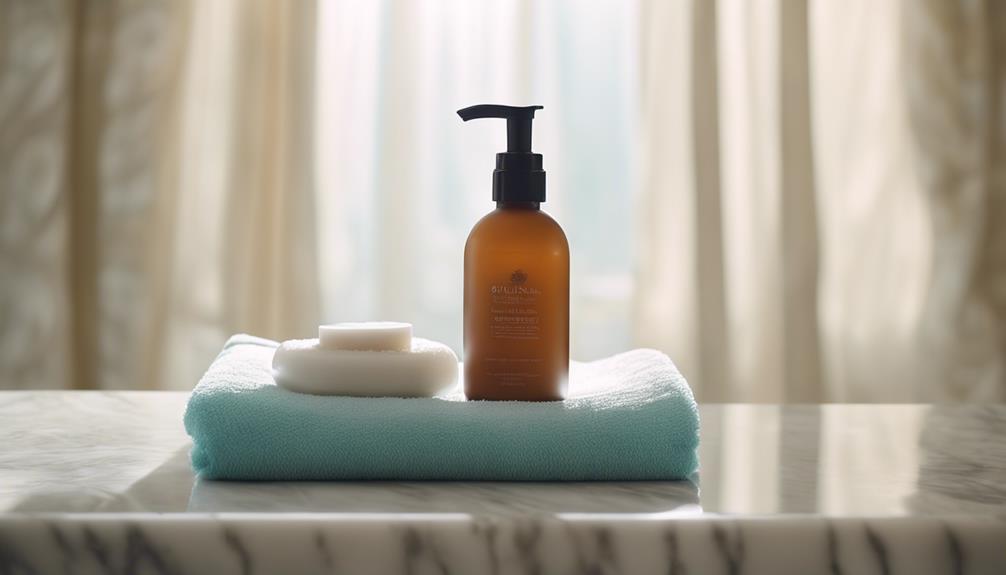
Preparing your skin for tanning involves exfoliating to confirm an even color and moisturizing to prevent dry patches that could affect the final result. Start by exfoliating your skin gently, removing dead cells for a smooth canvas. Next, apply a good moisturizer, focusing on areas prone to dryness like elbows and knees. Avoid using scented or oily products before tanning, and make certain to shave or wax at least 24 hours prior to your session for ideal results.
| Step | Action | Notes |
|---|---|---|
| Exfoliate | Use a gentle scrub | Focus on rough areas |
| Moisturize | Apply a hydrating lotion | Avoid oils and fragrances |
| Prep Timing | Shave or wax 24 hours in advance | Confirms skin is smooth |
Choosing Safe Tanning Products
When it comes to selecting tanning products, prioritize those designed to minimize skin damage while providing a natural-looking glow.
Look for self-tanning lotions and sprays that contain DHA, which safely darkens your skin without the risks associated with UV exposure. Gradual tanning lotions allow you to build color over time, giving you better control over your desired shade.
Always choose bronzers that match your skin tone for the most natural appearance, and opt for matte finishes to avoid excessive shine.
Remember to test products in natural light to guarantee an even application. Using tanning mitts can help achieve a streak-free look, making your tanning routine safer and more effective.
Your skin will thank you!
Recognizing Overexposure Symptoms
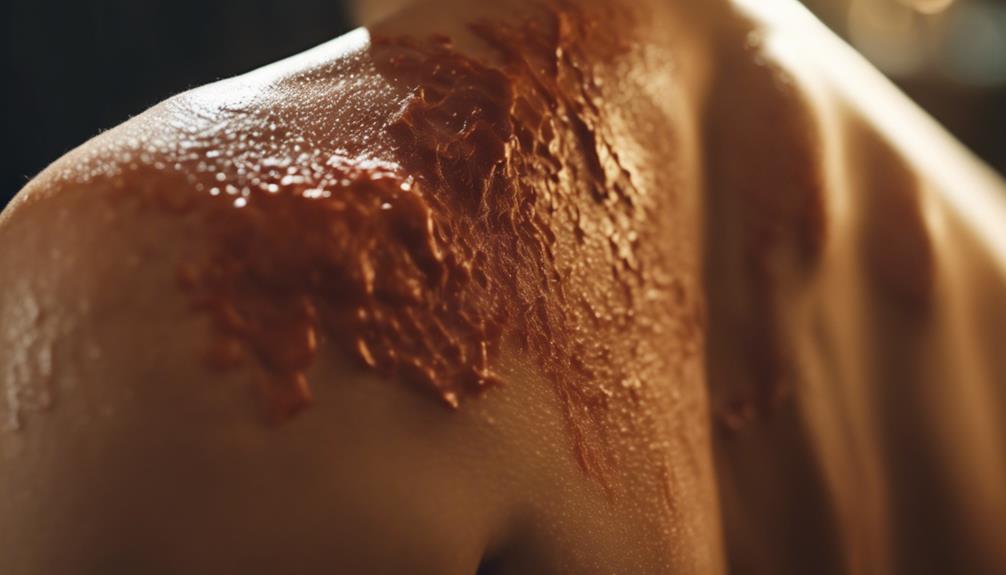
Recognizing the symptoms of overexposure to UV rays is essential for maintaining healthy skin and preventing long-term damage.
If you notice redness, tenderness, or a burning sensation on your skin after a tanning session, it's a clear sign you've overdone it.
Peeling skin indicates your body is trying to heal from the damage, while dizziness can signal more severe reactions.
Don't ignore these symptoms; they're your body's way of telling you to take a break.
To protect your skin, keep track of how often you tan and limit your sessions.
Always prioritize skin health over a temporary glow, and consider alternatives like self-tanners for a safer, healthier approach to achieving that bronzed look.
Frequently Asked Questions
How Often Should I Get Skin Checks After Using Tanning Beds?
You should get skin checks at least once a year after using tanning beds. If you notice any changes or new moles, see a dermatologist sooner to guarantee your skin stays healthy and protected.
What Are the Long-Term Effects of Tanning Bed Use on Skin Health?
Tanning bed use can lead to long-term skin damage, including premature aging, increased risk of skin cancer, and DNA damage. You should consider safer alternatives to protect your skin's health and appearance over time.
Can Tanning Beds Provide Any Benefits Beyond Cosmetic Tanning?
Tanning beds might seem like a quick fix, but they don't offer real benefits beyond cosmetic tanning. Instead of seeking a temporary glow, consider healthier alternatives that protect your skin and overall well-being.
Are There Specific Skin Types More Susceptible to Tanning Bed Damage?
Yes, certain skin types, especially fair or sensitive ones, are more susceptible to tanning bed damage. If your skin burns easily or has a history of issues, you should be particularly cautious about using tanning beds.
How Do Tanning Beds Compare to Natural Sunlight Exposure in Terms of Risk?
Tanning beds and natural sunlight both expose you to harmful UV rays, increasing skin cancer risk. However, tanning beds often emit more concentrated UVA rays, heightening the danger. Consider safer alternatives for your skin's health.
Conclusion
In your quest for that perfect tan, it's easy to overlook the risks of tanning beds.
Coincidentally, while you might think you're boosting your glow, you could be increasing your chances of skin cancer considerably.
Remember, prioritizing your skin health today could mean a brighter, safer future.
Instead of artificial tanning, consider sunless options or natural methods that keep your skin radiant without the dangers.
Protect yourself—your skin will thank you!
-

 Vetted2 months ago
Vetted2 months ago14 Best Personalized Father's Day Gifts for Your Husband – Show Him You Care
-

 Alfresco1 month ago
Alfresco1 month agoAlfresco Stacker Doors: Seamless Indoor-Outdoor Living!
-

 Craft and Textiles3 months ago
Craft and Textiles3 months ago15 Best Places to Buy Appliances for Your Home – Top Retailers Reviewed
-

 Decorative Throws3 months ago
Decorative Throws3 months agoIs It Better to Dry Clean Blankets?
-

 Tableware and Dining Accessories3 months ago
Tableware and Dining Accessories3 months agoWhat Is the Hindi Meaning of Tableware
-

 Tableware and Dining Accessories3 months ago
Tableware and Dining Accessories3 months agoWhat Is the Meaning of the Word Tableware
-

 Craft and Textiles3 months ago
Craft and Textiles3 months ago15 Best Cordless Mowers for Effortless Lawn Care – Top Picks of 2024
-

 Yarn3 months ago
Yarn3 months agoIs Yarn Natural or Manmade? Unravel the Truth






















